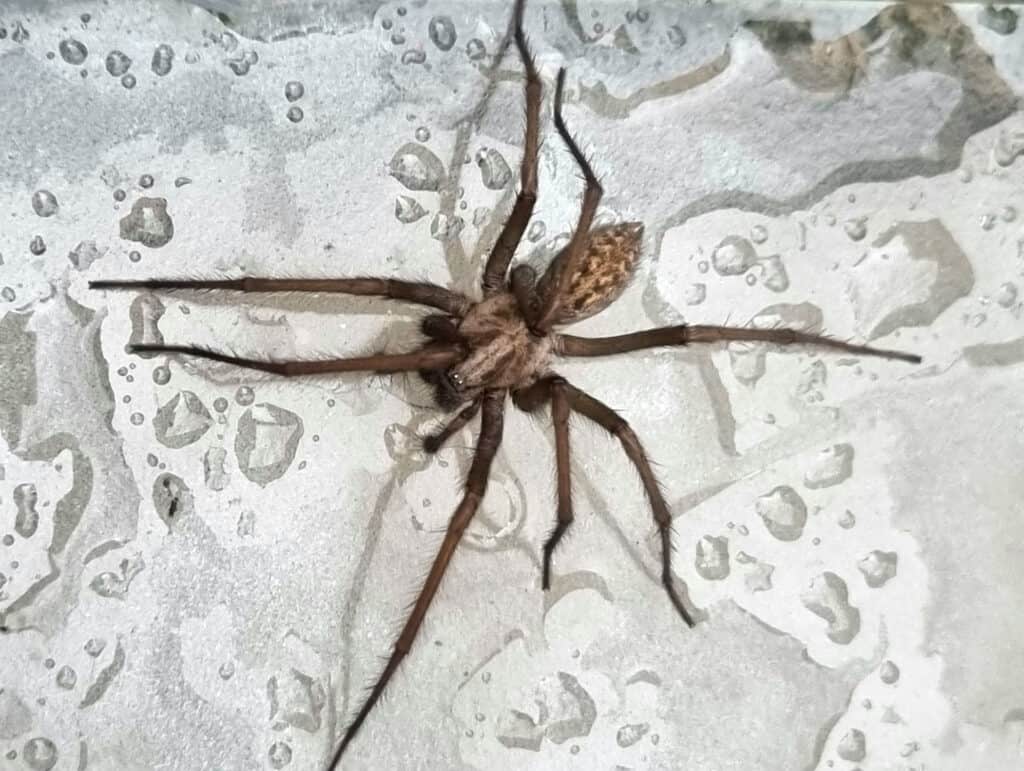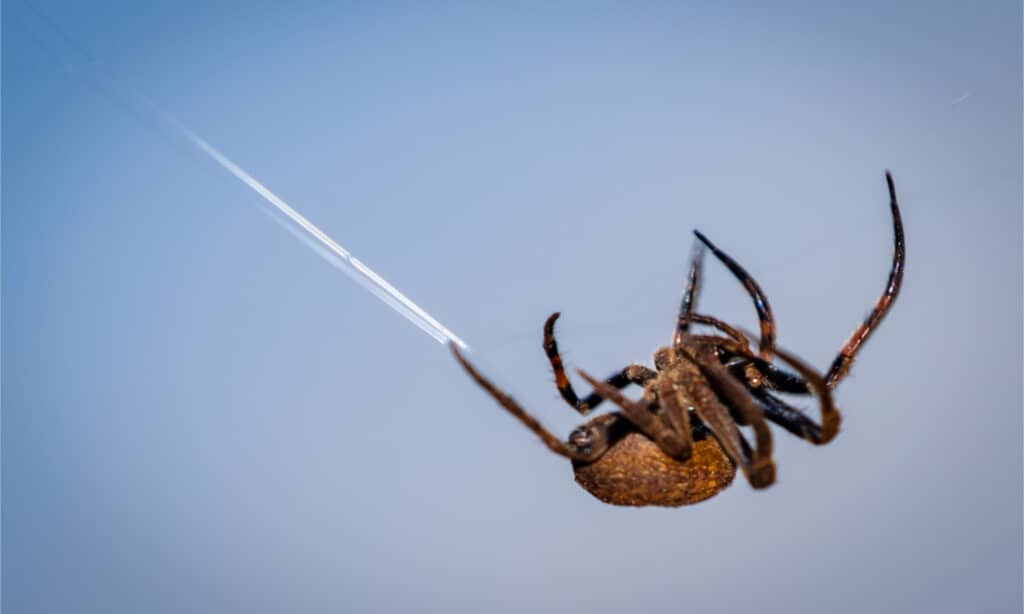Spiders are fascinating creatures that have many unique characteristics. One of the questions people often ask is whether spiders are nocturnal or diurnal. The answer to this question is that they can be either diurnal, nocturnal, or crepuscular, as a spider’s sleep behavior varies depending on the species. However, most spiders are generally more active at night and less during the day. In this post, we explore the various factors that influence a spiders’ sleep behavior and possible explanations for why they might be more active during the night.
What Are Spiders?

Depending on the species, spiders can be nocturnal, diurnal, or crepuscular.
©iStock.com/Kelly McCutcheon
Spiders are one of the most ubiquitous and fascinating creatures in the animal kingdom. They are air-breathing arthropods with eight legs and chelicerae or mouthparts with fangs that inject venom. If spiders are non-venomous, they may simply inflict a dry bite under duress.
They rank seventh in total species diversity among all other groups of organisms, showing just how incredibly diverse they genuinely are. Spiders can be found worldwide on every continent except Antarctica, living nearly everywhere except in highly saline environments such as oceans and seas.
Thanks to their adaptability, they have become established in many habitats, including forests, grasslands, deserts, mountains, caves, wetlands, and even urban areas like buildings and sidewalks. As of 2008, taxonomists estimate that there are approximately 40,000 spider species and 109 different families known to exist throughout the world.
Diurnal vs. Nocturnal Spiders
In their rest and activity cycles, many different spiders can be either diurnal or nocturnal. Diurnal spiders typically have excellent eyesight, using their vision to find and hunt their prey during the day. Conversely, nocturnal spiders rely on their webs to detect movement and track down their food.
Each type of spider has its unique abilities, which are suited to its daily or night-time habits. For example, some diurnal spiders have more substantial and robust webs that can withstand the UV radiation from the sun’s rays. In contrast, nocturnal spiders may have a heightened sense of smell or heat signatures to sense nearby prey and potential predators better. Ultimately, these differences allow each type of spider to thrive and survive in its particular environment.
Which Species of Spider Are Diurnal?
Several species of spider are diurnal or active during the day. One example is jumping spiders, which typically hunt during the day due to their highly developed visual system. These spiders use their excellent eyesight for courtship, hunting, and navigation.
Several spider species are also active during the day, including Kite and Joro spiders. Whether hunting prey or looking for a mate, these diurnal spiders use their excellent vision to navigate their surroundings. So, no matter what their activity pattern, they take advantage of every opportunity that comes their way.
Which Spiders Are Nocturnal?
Nocturnal spiders are primarily active during the night when conditions such as temperature and lighting are ideal for hunting. Some of the most common examples of these spiders in North America include the orb weaver, the black widow, the brown recluse, and the wolf spider.
The orb weaver is a fast-moving nocturnal spider that is highly active at night. These arachnids build intricate nests using a combination of silk and vegetation. They may even dismantle these nests each morning before hunting for new prey.
Similarly, the black widow spider is known for its fearsome reputation, but it, too, is primarily nocturnal in its habits. These spiders prefer dark and out-of-the-way locations for their homes, such as under rocks or loose bark.
Another nocturnal species found throughout North America is the wolf spider. Unlike some other spiders, wolf spiders do not build webs. Instead, they set up burrows to wait for prey to pass, at which point they ambush their target. You may find them hunting early in the morning, but these arachnids are generally most active at night.
Do Spiders Sleep?

Web-building spiders are primarily nocturnal. They may only feed every few days as they wait to catch prey in their webs.
©Hassan Najmy/Shutterstock.com
When it comes to sleep, spiders behave quite differently than humans. They go through a slow-wave sleep phase, during which their metabolic rate decreases, and they become less active. This behavior allows them to conserve energy when food is difficult to find.
Most research suggests that spiders do not experience REM sleep like humans or certain animals. However, this view is slightly controversial, and more research is necessary to fully understand spiders’ sleep cycles.
Web-building spiders are uniquely dependent on long periods of inactivity for survival. With few exceptions, these spiders do not hunt for food. Instead, they wait for prey to lure them into their webs. Because prey can be in short supply sometimes, a spider might only eat once every several days or even longer.
During these periods of inactivity, slow-wave sleep allows them to rest until the next meal arrives. Although spiders might not experience REM or deep sleep like humans, their distinct daily cycles of activity and rest help them stay healthy and strong.
Unique Study – Diurnal Jumping Spiders Sleep
Sleep and sleep-like states are shared across the animal kingdom, from arthropods to cnidarians. While sleep patterns are well-documented in many taxa like mammals or birds, understanding sleep phases in less-studied groups is still somewhat lacking.
In particular, scientists know much less about rapid eye movement (REM) sleep in insects and spiders. Their eyes are generally immobile and can’t move like vertebrate eyes. However, recent studies demonstrate that certain features associated with REM sleep may exist across many different animals.
Intriguing new research suggests that even tiny creatures like the diurnal jumping spider may undergo sleep cycles that resemble those observed in humans. According to this study, jumping spiders enter a kind of REM sleep-like state during the night. While resting, they exhibit recognizable behaviors such as twitching limbs and curling their legs in a specific way.
These patterns are regular and consistent over time, suggesting that these little creatures have complex sleep patterns as we do. Such findings shed new light on our understanding of non-vertebrate behavior and how different species experience the world around them. Who knows what other secrets these fascinating little arachnids might hold?
Do Nocturnal and Diurnal Spiders Hibernate?

New research shows that the diurnal jumping spider may experience sleep as people do.
©iStock.com/Thien Woei Jiing
When it comes to nocturnal and diurnal spiders, the answer can be a bit complicated. Depending on the species, some spiders may hibernate throughout the cold winter months while others do not. For example, species such as Argiope, certain widow varieties, and garden orb weavers die off in the winter and leave their egg sacs behind for the next season.
In contrast, some adult spiders survive through the cold weather by seeking protected areas such as beneath loose bark or inside rock piles or leaf litter. Additionally, some spiderlings hatch in their webbed egg sacs throughout winter and remain there until warmer temperatures arrive. These animals can live off insects that are easier to capture in their dormant states.
What Can Nocturnal and Diurnal Spiders See?
Most spiders have poor eyesight and cannot see in the dark. This limitation is because their other senses – such as touch, vibration, and taste stimuli – are generally more developed. However, there are exceptions to this rule. Some species of spiders have powerful visual abilities and can see even in low-light conditions. This ability is due in part to their possession of a special membrane, the tapetum lucidum. The tapetum lucidum reflects light into their eyes and enables them to see more clearly.
Additionally, some species of spiders have even more advanced visual capabilities than others. For example, while most spiders can only see in shades of gray, some jumping spiders can see in three color channels rather than just two. Overall, it is clear that when it comes to visual ability, each spider species has its unique strengths and weaknesses depending on its specific requirements.
Nocturnal vs. Diurnal: What’s The Difference?
Navigate to Nocturnal vs. Diurnal: What’s The Difference? for further information about the nocturnal and diurnal phenomenon in various living creatures.
Up Next –
The photo featured at the top of this post is © Dave Montreuil/Shutterstock.com
Sources
- Current Biology, Available here: https://www.cell.com/current-biology/fulltext/S0960-9822(15)00348-6?_returnURL=https%3A%2F%2Flinkinghub.elsevier.com%2Fretrieve%2Fpii%2FS0960982215003486%3Fshowall%3Dtrue
- National Academy of Science, Available here: https://www.pnas.org/doi/full/10.1073/pnas.2204754119#sec-2
- Springer Nature Limited, Available here: https://www.nature.com/articles/pj2010119
- BioOne, Available here: https://bioone.org/journals/the-journal-of-arachnology/volume-42/issue-2/J13-66.1/Nocturnal-diurnal-crepuscular-activity-assessments-of-Pisauridae-and-Lycosidae/10.1636/J13-66.1.short
Thank you for reading! Have some feedback for us? Contact the AZ Animals editorial team.






